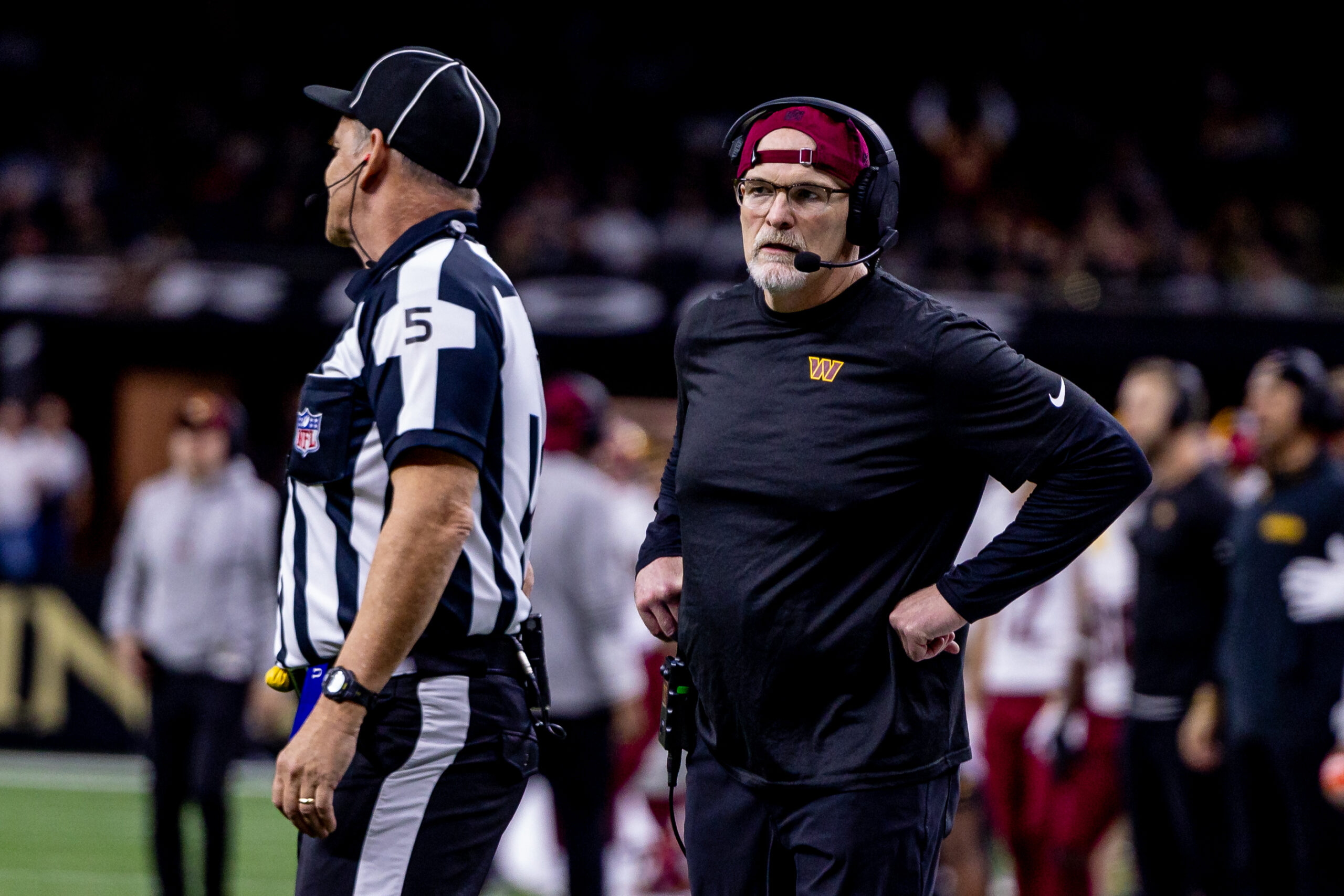Fantasy
11/25/23
9 min read
How To Handle Week 12 Chalk in DFS

It's common for DFS players to key in on the same expected top plays each week, or 'chalk plays' if you will. Each week, we'll look at the expected chalk plays with tips and best practices to improve your roster construction.
We’ll also explore theoretical and conceptual areas of roster construction in DFS as we examine various pieces of chalk throughout the season, with the goal being to grow as players along the way. Numerous tips, or best practices, will emerge from this exploration. With that, and in our best Bruce Buffer voice, it’s time!
Week 12 Chalk
 Trey McBride, Arizona Cardinals
Trey McBride, Arizona Cardinals
Another week, another slate where Arizona Cardinals second-year tight end Trey McBride is expected to garner the most ownership on the slate. Expect this week he is a better on-paper play than at any other point this season but is at the highest price of the year. I’ll be looking for ways to play McBride smartly where I do play him.
 Jonathan Taylor, Indianapolis Colts
Jonathan Taylor, Indianapolis Colts
We’ve seen the Indianapolis Colts overcome difficult on-paper rushing matchups in multiple spots this season and Jonathan Taylor has worked his way back into a workhorse role, playing 88 percent of the team’s offensive snaps in Week 10 before their Week 11 bye.
Even so, the Tampa Bay Buccaneers have held opposing backs to just 3.7 yards per carry behind 1.12 yards allowed before contact, both of which rank top five in the league. The Buccaneers are also one of only two teams yet to allow a rushing score to a running back this season, resulting in just 16.8 DK points allowed per game to the position.
I legitimately don’t understand how the field can be so certain with Taylor in this spot, who currently appears to be one of the most owned plays of the season.
 Evan Engram, Jacksonville Jaguars
Evan Engram, Jacksonville Jaguars
Here we go again with Evan Engram. Engram has seen seven or eight targets in a whopping seven of 10 games played this season, providing an excellent volume expectation. That said, he holds a modest 10.0 percent red zone target share (just three red zone targets all year) and silly 4.4 aDOT, resulting in zero touchdowns and no more than 88 yards in a game this season. That is not a profile you play at ownership, even if there’s a fire.
 Michael Pittman Jr., Indianapolis Colts
Michael Pittman Jr., Indianapolis Colts
I was surprised to see Michael Pittman Jr. among the leaders in expected ownership on this slate. The matchup is great against the pass-funnel Buccaneers defense that utilizes elevated rates of Cover-1 and Cover-3.
Still, an 8.1 aDOT on routes that don’t tend to lead to additional per-target upside (his prototypical “X” wide receiver role has him running many possession-type routes) leaves much to be desired. That should be evidenced by his one game of 100 yards or more receiving while seeing 11 or more targets a massive six times already this year.
Pittman is very clearly priced for his median outcome and is now at his highest salary of the season, up at $6,800. This is a spot I’m fine being underweight on at ownership, as he is highly unlikely to fully burn you for not playing him.
 New England Patriots D/ST
New England Patriots D/ST
We’re really excited to play a defense generating the fifth lowest rate of pressure that has generated just 10 total turnovers through 10 games played at ownership? I’m not.
 Dalton Kincaid, Buffalo Bills
Dalton Kincaid, Buffalo Bills
I get it, Dalton Kincaid’s involvement has been both solid and consistent with Dawson Knox out of the lineup. That said, Kincaid’s likeliest range of outcomes leads to six to seven targets in a matchup that is no more difficult for tight ends after the Philadelphia Eagles signed Kevin Byard at the deadline.
Kincaid has a solid point-per-dollar median projection but leaves a lot to be desired in the upside side of the discussion here.
 Christian Kirk, Jacksonville Jaguars
Christian Kirk, Jacksonville Jaguars
Jacksonville Jaguars' pass-catchers, as a unit, have five games of 100 or more yards through the air this season. This is simply an unconcentrated, moderate volume pass offense with a head coach and offensive play caller that requires outside influence to increase the aerial aggression. In other words, we better be playing a member of the Houston Texans if utilizing any Jaguars skill position player this week.
A State (Slate) of Chaos
This is the busiest week during the NFL season for a lot of people. You’ve probably noticed that content providers are getting content up later than usual this week. The same is true for the DFS field, who not only had to deal with the holiday festivities via travel, family time, and other distractions, but were also thrown an additional premier slate for Thanksgiving Day and an additional slate in the form of the first ever Black Friday NFL football game this year.
That has left fewer hours in the week to dedicate to the Week 12 main slate, which is likely to lead to a larger portion of rosters dead on arrival when compared to a normal main slate. How, then, do we set ourselves up to maximize expected value while fighting against the same external distractions as the rest of the field?
Just play the best plays. OK, so it’s not as simple as that, but this slate provides some unique opportunities that we have not seen in recent weeks. To fully understand what I mean by that statement, let’s first return our attention to what leverage actual is, and how we go about generating leverage on the field.
We have standard optimal practices in DFS that have been proven through rigorous study, reflection, and data crunching. And that’s the same for any game, and the same for game plan development through game theory. We take what we know, we introduce observations from our competition, we make assumptions that lead to hypotheses, and then we re-evaluate.
Leverage enters the discussion in the road from the first step to the second step, when we begin to introduce outside factors such as field tendencies, ownership expectations, and observations. Leverage then becomes easier to understand, defined through the act of deviating from optimal practices to generate a boost to expected value equal to or greater than the loss in expected value from the deviation itself. This is leverage, and it’s made possible through an exploitative stance against field tendencies.
On any given slate, the magnitude of the deviation from optimal will vary and take different forms. Which brings us back to the Week 12 slate. From my observations and study of the chalk on the slate, and how that chalk interacts under the umbrella of the $50,000 salary cap, we can make three primary observations.
First, the field seems to be struggling to identify the clear top expected game environment on the slate (made possible via the composite ownership from each game on the slate, with the Bills-Eagles game checking in far behind some more fragile game environments).
Second, the field seems to be struggling to identify “projectable value,” or players priced below $5,000 that carry solid point-per-dollar median projections. This is important for how we can expect the field to construct rosters. Finally, the field seems to be struggling to identify the top on-paper plays at the running back position.
Chalk Fragility and You
Because the chalk is more fragile on this slate than we have seen at any point this season, the magnitude of deviation from optimal needed to generate leverage decreases. This leads us back to the opening statement in this discussion – just play the best plays.
Now, additional considerations are introduced to that equation due to the salary cap and other governing constraints found in DFS, but the general idea remains. If the field is making more mistakes or taking more deviations away from optimal, we can theoretically gain leverage simply by playing the best plays on paper. Or we can think through how to play the “good chalk optimally” plays in ways the field is unlikely to utilize.
For example, the general lack of projectable value on this slate is likely to lower the combined ownership of the players from the top game environment of the week (Buffalo-Philadelphia) because the players in that game are generally high-priced plays. People can’t comfortably get to those players without stretching themselves too thin throughout the rest of their rosters.
One of the few exceptions is Kincaid, who is coming in at extreme ownership due to his lower price. He is an easy option for people to click on this week because we can rationalize a suboptimal play on paper by getting exposure to the top game environment on the slate at lower salary.
It's a similar case for both Taylor and Pittman. People can rationalize clicking players who have yet to show elite ceiling because they want exposure to one of the top expected game environments for lower salary due to the relative lack of projectable value plays on the slate.
The Buccaneers have yet to cede a rushing score this season and are top five in fantasy points allowed to the running back position, most notably holding Christian McCaffrey to just 3.7 yards per carry just last week. Pittman has just one game all season with more than 100 yards receiving on a modest 8.1 aDOT role for the Colts. And yet, the field is jumping over itself to force these players into rosters this week because they’re easy to rationalize to gain exposure to the game environment.
Again, what about the Bills and Eagles? What about Derrick Henry, Kyren Williams and Jaylen Warren? What about Greg Dortch? Can’t we play Dortch, who has historically commanded targets at a higher rate than Marquise Brown and Rondale Moore, together with McBride as a way to differentiate our McBride exposure?
As you can see, the magnitude of deviations required to generate leverage on this slate is smaller than we have seen recently. The individual players discussed above are not the only “top plays” on the slate, nor were the ways discussed the only ways to play those situations. I simply wanted to highlight the theoretical thought process that leads to more sustainably profitable DFS play. For Week 12, just play the best plays!
That will do it for our Week 12 exploration of chalk and some theoretical and conceptual takeaways. We’ll run this series every week of the 2023 season, picking out new learning points each week. I welcome all feedback with this new column, so please don’t hesitate to reach out to let me know things you like or things I could do better.
Follow The 33rd Team Podcast Network on Spotify and Apple Podcasts.








